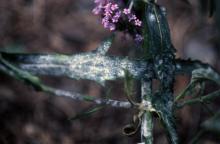See:
Greenhouse Plants, Ornamental - Powdery Mildew
Cause The fungus Golovinomyces cichoracearum (formerly Erysiphe cichoracearum) has been reported from Washington. Several fungi occur worldwide including G. ambrosiae, G. orontii, G. verbenae, E. verbinicola, Podosphaera verbenae and P. xanthii (common in Eastern North America). It is not certain which type is found in the PNW. Only one plant sample sent into the OSU Plant Clinic in 50 years was diagnosed with powdery mildew. This fungus is favored by conditions that produce high humidity but dry leaves. It is a highly specialized pathogen that forms a close association with the host. Conditions that favor the host also favor the pathogen. Much of the fungus remains outside infected plant parts where it grows on the surface but sinks root-like structures called haustoria into plant cells to obtain nutrients. The white growth seen is composed of both mycelium and fungal spores.
Symptoms Colonies appear as the typical powdery, white patches on leaf surfaces. A purpling and chlorosis of the upper leaf surface is also associated with powdery mildew of verbena. This symptom could also be confused with nitrogen deficiency. Colonization is generally on the leaf underside. Lower leaves generally are the first to show symptoms and later become necrotic.
Cultural control
- Space plants for good air circulation.
- Media pH should be between 5.8 to 6.2 and check the electrolyte concentration at regular intervals.
- There are differences in cultivar reaction so select verbena cultivars that are more resistant such as Aztec Grape Magic, Aztec Lilac Picotee, Aztec Magic Purple, Aztec Silver Magic, Aztec Wild Rose, Lanai Royal Purple with Eye, Rapunzel Hot Rose, Rapunzel Orchid, Superbena Dark Blue, Superbena Large Lilac Blue, and Superbena Pink Shades. Reactions of these cultivars is based on P. xanthii.
Chemical control Fungicides will do best when used before symptoms develop. Scout the lower leaves for initial colonies. Few materials have good eradicant activity. Use at 7- to 14-day intervals; using shorter intervals when environmental conditions favor disease development. Alternate or tank-mix products from different groups that have different modes of action. Limit the use of any one group during crop production.
- Avelyo at 3 to 5 fl oz/100 gal water. Group 3 fungicide. 12-hr reentry.
- Bicarbonate-based products. Might supplement a normal program when powdery mildew is first observed. Do not mix with acidifying agents. Thorough coverage is essential. O
- MilStop (85% potassium bicarbonate) at 2.5 to 5 lb/A in the field or 1.25 to 5 lb/100 gal water in the greenhouse. Oregon and Washington only. 1-hr reentry.
- Monterey Bi-Carb Old Fashioned Fungicide at 4 teaspoons/2 gal water. H
- Broadform at 2 to 4 fl oz/100 gal water. Group 7 + 11 fungicide. 12-hr reentry.
- Compass 50 WDG at 1 to 2 oz/100 gal water. Do not use organosilicate additives. Group 11 fungicide. 12-hr reentry.
- Disarm 480 SC at 1 to 4 fl oz/100 gal water. Group 11 fungicide. 12-hr reentry.
- Eagle 20 EW at 6 to 12 fl oz/100 gal water. Group 3 fungicide. 24-hr reentry.
- Fame SC at 1 to 4 fl oz/100 gal water. Group 11 fungicide. 12-hr reentry.
- Heritage at 1 to 4 oz/100 gal water plus a non-silicone-based wetter sticker. Group 11 fungicide. 4-hr reentry.
- Insignia SC at 3 to 6 fl oz/100 gal water. Do not use with organosilicate-based adjuvants. Use preventively only. Group 11 fungicide. 12-hr reentry.
- Mural at 4 to 7 oz/100 gal water. Group 7 + 11 fungicide. 12-hr reentry.
- Orkestra at 6 to 8 fl oz/100 gal water. Group 7 + 11 fungicide. 12-hr reentry.
- Pageant at 6 to 12 oz/100 gal water. Do not use with organosilicone-based adjuvants. Group 7 + 11 fungicide. 12-hr reentry.
- Pipron at 4 to 8 fl oz/100 gal water plus a surfactant. Greenhouse use only. Group 5 fungicide. 12-hr reentry.
- Seido at 4 to 5 fl oz/100 gal water plus an adjuvant. Group 50 fungicide. 4-hr reentry.
- Terraguard SC at 4 to 8 fl oz/100 gal water. Group 3 fungicide. 12-hr reentry.
- Tourney EZ at 1 to 4 oz/100 gal water. Group 3 fungicide. 12-hr reentry.
- Trinity at 4 to 12 fl oz/100 gal water. Group 3 fungicide. 12-hr reentry.
Biological control
- Cease or Rhapsody (Bacillus subtilis strain QST 713) at 2 to 8 quarts/100 gal water. Active ingredient is a small protein. Efficacy in the Pacific Northwest is unknown. Did not do well in Michigan trials. 4-hr reentry. O
References Daughtrey, M.L., Wick, R.L., and Peterson, J.L. 1995. Compendium of Flowering Potted Plant Diseases. St. Paul, MN: APS Press.
Sconyers, L.E. and Hausbeck, M.K. 2005. Evaluation of verbena cultivars for resistance to powdery mildew, 2004. B&C Tests Vol 20:O015

